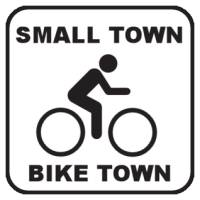 Upon hearing that my wife and I were moving to a small Kansas town, some of my friends were surprised at our choice, assuming that if I moved, it would have been to a more bike-friendly city.
Upon hearing that my wife and I were moving to a small Kansas town, some of my friends were surprised at our choice, assuming that if I moved, it would have been to a more bike-friendly city.
And I’ll admit, a town like Iola is not the kind of place that most people think about when they hear the phrase “bicycle friendly community“.
Indeed, I’m not sure if a town as small as Iola has ever been designated a Bicycle Friendly Community by the League of American Bicyclists, since the League typically focuses on infrastructure investments (bike lanes and such) and special education or advocacy programs, and such things are less likely to exist in a small town.
But let me ask you this: Which is more “bicycle friendly”, a community, such as Iola, where it’s rather easy to get around by bike (due to short distances, a robust street grid, and low traffic volumes), or a larger city where bike lanes and other infrastructure have been added to help compensate for a built environment that’s been optimized almost exclusively for maximum motor vehicle traffic throughput?
Obviously, both types of situations can be bike-friendly, under the right circumstances.
But with this move, I’m gambling that Iola, with almost no on-street bicycling-specific infrastructure, will be a relatively easy place to use a bike for daily transportation. Indeed, I expect to be able to walk or bike for nearly all my day-to-day travel — shopping, errands, business, recreation — and only use the car for out-of-town trips, carrying huge loads, or in dangerous weather.
(Ironically, I may end up driving more — perhaps fewer trips, but more miles — due to greater distances to visit family and to get to “the city”.)
If this concept proves correct, I’m not sure of the significance, on a larger scale.
To benefit the greatest number of people, bicycle friendliness initiatives almost have to be targeted at larger communities. And, given that the cores of most cities are grids (and are hence somewhat bikeable and walkable as-is, albeit all-too-often chopped up by freeways and high-speed through roads), the suburban areas are really where the most effort is needed, and also where the most difficult (and expensive) engineering solutions are needed … and the greatest attitudinal shift would be required.
But I wonder: Since there are so many small towns, and many of them are already relatively bike-friendly (or at least not overtly bicycle-hostile), is that somewhere we (as cycling advocates) should be focusing attention?
The Rails-to-Trails Conservancy published a report last year that sort of focused on this idea:
Whether it’s the economic impact of a tourist destination trail network, or the vital importance of transportation options in population centers without significant public transit, walking and biking are truly woven into the fabric of rural life.
Yet there has long been an assumption that walking and biking are strictly “big city” phenomena–and that rural Americans can’t benefit substantially from investment in bicycling and pedestrian infrastructure. It is an assumption a number of elected officials–including many who represent rural areas- have used to argue against spending money on sidewalks, bike paths and trails in their communities.
But RTC’s important new analysis tells a much different story.
 Is a small-town bicycle-friendly movement a possibility?
Is a small-town bicycle-friendly movement a possibility?
It certainly seems possible. One significant factor is that, in a smaller community, it may be much less daunting to “move the needle” than it is in a larger city. That is, just a few more people biking is a much larger statistical swing among a smaller population than among a larger population.
Anyway, these are some of the ideas I hope to be ruminating on over the next few years, as I find out for myself how easy it is to use a bicycle for everyday transportation in a small rural Kansas town.
See also: Active Transportation Beyond Urban Centers: Walking and Bicycling in Small Towns and Rural America and Principles for Improving Transportation Options in Rural and Small Town Communities
Post tags: Bicycle Friendly, Iola



Claflin is a small town in central Kansas that seems very bike friendly to me. A measure of the bike culture in the area could be how quickly a team came together from the area to participate in the National Bike challenge and how well it did. Oldsters and youngsters alike ride all over the town. The activity leads to more community awareness, which in turn leads to safer behavior. Nobody wants to run over their neighbor, and everybody is a neighbor in this area. Organized rides like “Miles for Mikal” at the beginning of the season, and the Ellsworth to Holyrood “Ride for Health” at the end also provide a sense of group and gathering.
But there are currents running in the opposite direction. An example is the bike rack that used to grace the front of the high school. It is now located in the edge of a tree grove by the football field a good 200 yards from the building. I don’t think anyone uses it anymore or even knows where it is. That makes a strong statement that bicycles aren’t for (young) adults. It may be a response to observed behavior. It waits at its current location for the users to call it back, and if no one does, it will disappear for good.
I believe a bicycle culture is built by people who enjoy, benefit, and witness to their experience. I appreciate the opportunities in my home area, especially the wide shoulders on US 156 between Claflin and Holyrood. I ride the ten miles to and from work in the spring/summer to witness to the alternatives and benefits available beyond car transportation. With the US-156 layout I don’t have to risk my life to commute. You could say I’m riding on the shoulders of a far-sighted tranportation engineer.
Sounds awesome, John! I’ve never been there, but it’s on my list…
Nice job with the National Bike Challenge! Clafin did really well, as did nearby Ellinwood and Holyrood.
Randy, my wife and I agree with your assessment of small towns. We are looking at relocating from Wichita to a smaller community in order to ‘get out’ and do more riding on the back roads. Part of our requirement is to have access to trails that would allow us to visit other towns. As one retires we realize that collecting more stuff is petty in comparisons to adding to our memories.
Exactly, Bob! We’ve looked at the stuff we’ve accumulated in the 27 years we were at the old house, and realized how little of it we actually needed.
And yet, sorting thru things, and getting rid of a good portion, is turning out to be quite the process…